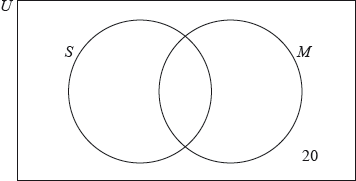| Date | May 2022 | Marks available | 5 | Reference code | 22M.1.SL.TZ2.9 |
| Level | Standard Level | Paper | Paper 1 (without calculator) | Time zone | Time zone 2 |
| Command term | Find | Question number | 9 | Adapted from | N/A |
Question
A biased four-sided die with faces labelled and is rolled and the result recorded. Let be the result obtained when the die is rolled. The probability distribution for is given in the following table where and are constants.
For this probability distribution, it is known that .
Nicky plays a game with this four-sided die. In this game she is allowed a maximum of five rolls. Her score is calculated by adding the results of each roll. Nicky wins the game if her score is at least ten.
After three rolls of the die, Nicky has a score of four.
David has two pairs of unbiased four-sided dice, a yellow pair and a red pair.
Both yellow dice have faces labelled and . Let represent the sum obtained by rolling the two yellow dice. The probability distribution for is shown below.
The first red die has faces labelled and . The second red die has faces labelled and , where and . The probability distribution for the sum obtained by rolling the red pair is the same as the distribution for the sum obtained by rolling the yellow pair.
Show that and .
Find .
Assuming that rolls of the die are independent, find the probability that Nicky wins the game.
Determine the value of .
Find the value of , providing evidence for your answer.
Markscheme
uses to form a linear equation in and (M1)
correct equation in terms of and from summing to A1
OR (or equivalent)
uses to form a linear equation in and (M1)
correct equation in terms of and from A1
OR (or equivalent)
Note: The marks for using and the marks for using may be awarded independently of each other.
evidence of correctly solving these equations simultaneously A1
for example, or
so and AG
[5 marks]
valid approach (M1)
OR
A1
[2 marks]
recognises at least one of the valid scores (, or ) required to win the game (M1)
Note: Award M0 if candidate also considers scores other than , or (such as ).
let represent the score on the last two rolls
a score of is obtained by rolling or
A1
a score of is obtained by rolling or
A1
a score of is obtained by rolling
A1
Note: The above 3 A1 marks are independent of each other.
A1
[5 marks]
(M1)
A1
[2 marks]
METHOD 1
EITHER
A1
OR
and A1
OR
and A1
THEN
A1
Note: Award A0A0 for obtained without working/reasoning/justification.
METHOD 2
EITHER
correctly lists a relevant part of the sample space A1
for example, or
or
OR
eliminates possibilities (exhaustion) for
convincingly shows that A1
, for example, from and so
THEN
A1
[2 marks]
Examiners report
A majority of candidates knew to set up equations using the sum of the probabilities in the distribution equal to 1 and/or the expected value equal to 2, however some candidates simply substituted the given values of and into their equations, which is considered working backwards and not doing what is required by the command term "show that". For the candidates who did set up both equations in terms of and , nearly all were successful in solving the resulting system of equations. Many candidates answered part (b) correctly using the given values from part (a). In part (c), most candidates recognized a sum of 6 (or more) was required in the final two rolls, but very few were able to find all the different outcomes to make this happen, especially for sums that can happen in more than one way, such as and . While some candidates were able to correctly answer parts (d) and (e), some did not attempt
these questions parts, and many did not justify their final answer in part (e).


